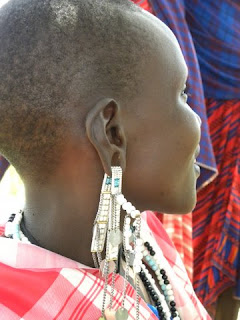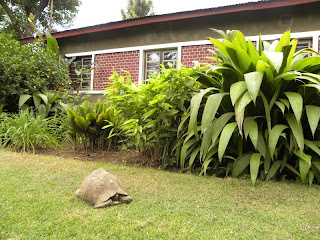February 23-24, 2010
They say that no American residents or medical students have taken call at Selian in a long time. The American preceptors offer to the volunteers the opportunity to take call, but no one has taken them up it. And why is that? Well, the hospital is not exactly set up for overnight Westerners. There’s few places to sleep that are decent, there’s no food, no source of clean water, minimal lighting between the buildings, and overwhelming mosquitoes with inadequate screens on the windows. It sounds like a pretty miserable place to spend the night.
Although I have been experiencing plenty during the daytime, our rounding teams are so large with Tanzanian interns, upper level residents, advanced medical officers, and American volunteers, that I have struggled to find a place to immerse myself in order to get the most out of my four weeks here. Being in family medicine is both a blessing and a challenge--while the other volunteers have specialized interests and skills, such as in pediatrics, OB/GYN, or surgery, I am a generalist. I can work in any department and would like to gain experience in all parts of the hospital--adult medicine, pediatrics, and OB. However, four weeks does not allow a whole lot of time to do this. After spending my first two weeks on the OB service, I started to feel like I was missing out on the adult and pediatric services. I am going to start on medicine this week, but that means rounding with the large ten-plus-person team in the mornings. In order to get my hands on some admissions and emergencies, I knew that the best way to do this would be to take an overnight call.
Sanaa is one of the brightest interns of the current group of Tanzanians in training. She typically takes call every fourth night without an upper-level resident in house, meaning that the doctor’s call room is available. A group of Colorado volunteers just installed new screens on the windows of the wards as well as the call rooms, thus the timing was perfect for me to move into a mosquito-free space. On the morning of call, I packed up three bags of gear to survive the night--clean water, food for dinner and breakfast, mosquito net, head lamp, bug spray, scrubs, and reference books--and headed to the hospital for the next thirty hours.
8:30am--Morning report, which included a special presentation on neonatal resuscitation by a visiting Minnesota pediatrician.
9:15am--Rounding on OB starts.
10:00am--Nurse calls us urgently to OB. Leaning her ear down onto the rudimentary fetoscope, she hears that the baby’s heartbeat is very slow, less than 100 beats per minute. The portable bedside ultrasound that we miraculously have in the unit shows that the baby’s heartbeat is 80 bpm, far to slow. We call an immediate stat c-section and run to the OR to tell the staff to get ready. Within 15 minutes the OR is prepped, which is quite fast on Africa-time, and we are scrubbed and cutting. I am first-assisting, and the OB resident I’m working with has the baby out in less than 60 seconds from the first incision. The newly-educated neonatal resuscitation team is there and the baby’s heartbeat is 30 beats per minute--the baby is practically dead. They resuscitate her and bring her back to life. Our emergent operation left the mother in a mess, so we spend over an hour repairing the extension of our initial cuts. The baby survives and within hours is out of the incubator and with her mother who is recovering well.
11:00am--A second woman in labor has gotten stuck at 7 cm for the last several hours. When her water broke, there was thick meconium (or baby poo) in the fluid, which can cause respiratory problems for the baby. Given the limitations of resuscitation here, we decided to do a C-section. I assisted again in this surgery and everything went well.
2:00pm--The other American volunteers leave for the day. I am anxious to see them go as I won’t have them to lean on during my call!
3:00pm--Called to see a man who was admitted earlier in the day. He is very ill-appearing and is in respiratory distress. His oxygen saturation on room air is 65% (normal is above 93%). We put him on oxygen and check out his chest x-ray seeing that he has signs of TB. We start him on anti-tuberculosis medication and increase his antibiotic regimen. His saturation rises to 79%. With no treatment beyond oxygen, there’s not much else we can do.
3:30pm--We admit a 74-year-old woman to the medical ward with advanced cervical cancer that has diarrhea. I just had her on the GYN service last week so I know her story. Sanaa writes up her admission note and we talk to the family about getting her set up with hospice for symptom management at home.
4:30pm--A 2-year-old boy in the outpatient department has a broken upper arm above the elbow--a displaced supra-condylar humerus fracture. We lightly sedate him with valium, reduce his fracture, get his arm as straight as possible, and put a back-slab cast on it. All while he is screaming. His mother comforts him by saying in Swahili, “Look at the Mazungu (white person).” I feel like a circus monkey. The x-ray technician has left for the day and this is not an emergency, so the patient will come back tomorrow for another x-ray to make sure his fracture is lined up well.
5:30pm--A dalla dalla bus pulls up in front of the hospital with a family carrying a 15-year-old girl who is unconscious. Within 20 minutes she wakes up and acts normally. After getting the full story, it sounds like she is having seizures, but we have to rule out meningitis and malaria. I write up her admission note while Sanaa does her spinal tap.
7:00pm--A few admissions have come to the pediatric ward through the afternoon, so finally Sanaa and I have the time to tackle them. She admits a baby with gastroenteritis while I admit a 6-month-old with respiratory distress, likely pneumonia. I put the baby on ampicillin, chloramphenicol (which is no longer used in the US), and albuterol nebulizers. Luckily, a medical officer student is on call with us to translate for me.
9:30pm--Dinner! The interns invite me to their house behind the hospital for chicken, vegetables, and rice. They always eat together and include the intern on call. I don’t have to eat my pre-made peanut butter and jelly rolls.
10:30pm--Throughout the afternoon, four women came to the OB ward in labor. The OB nurse sends me a text message (on my borrowed cell phone), that one of them is ready to deliver! I run out of dinner and make it in time to deliver the baby. A girl! The woman suffers a terrible second degree perineal tear that takes hours to convince her to repair. In the end I repaired it, she was grateful, and she named her baby Jackie. This is a story that I will tell later…
3:00am--Two of my other laboring patients have mysteriously been stuck at 4cm of cervical dilation since they were admitted in the afternoon. I start them both on pitocin via IV. There is no electronic fetal monitoring here, so I keep my fingers crossed that the babies will tolerate it. The only monitoring is my ear against a plastic cone fetoscope next to their bellies.
3:30am--I go to bed and set my alarm to wake up and check the laboring patients. The doctor’s room is comfortable and quiet, and there is a mosquito net already hanging. There is a decent-sized spider on the ceiling in the bathroom, but I am too tired to care. She will eat the mosquitoes for me. (Those of you who really know me will understand that I must have been exhausted to not care.)
5:30am--Alarm wakes me up. I walk in the dark with my headlamp up to OB. One of my laboring patients is in a constant contraction of pain from the pitocin--hyperstimulation. The OB nurses don’t even know what that means. They look perplexed. I turn down the drip, but then decide to turn it off. She goes back into a regular pattern of contractions every 2-3 minutes. The other woman is barely contracting. Her pitocin drip is increased. Neither of these woman have made any cervical change. Another laboring patient has also been admitted, she is at 6cm.
8:00am--I check all three laboring patients. The first two still have not changed, but the babies have normal heartbeats and seem to be doing fine. I turn all pitocin off. I will talk to the team about doing C-sections. The third woman is at 8cm of dilation.
8:30am--Morning report. I present the admissions I did last night.
8:50am--The morning OB nurse Dorah pulls me out of morning report. The first laboring patient is having trouble--Dorah believes the baby is in distress. I grab the ultrasound and check for the heartbeat--it is too slow at 100 beats per minute. We call the OB team together and decide on an immediate C-section. The intern on the service and the upper-level resident does the surgery, while I and the other American resident prepare to resuscitate the baby. The baby comes out crying! We all sigh in relief.
10:00am--The second laboring patient has made no cervical change despite pitocin. We determine that her pelvis must be too small which is keeping the baby from descending. The team takes her for a C-section. Both the mom and the baby do well.
10:30am--The OB nurse Dorah calls for me in the operating room--the third laboring patient is ready to deliver. The delivery is smooth and uncomplicated. A baby boy is born.
12:30pm--I’m tired. I feel done. At home I would be meeting the limit of work-hour restrictions. For once, I decide to abide by this rule. I catch a ride with the other Americans home.























































